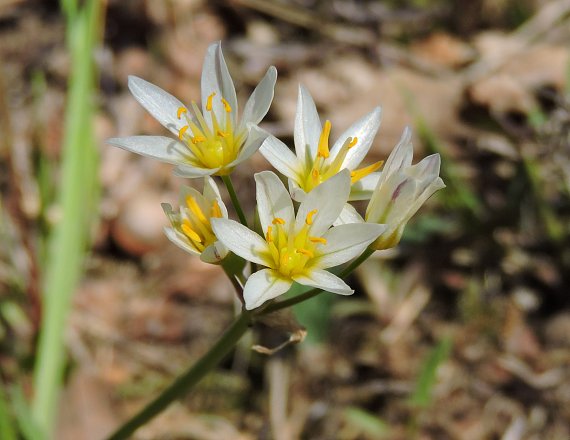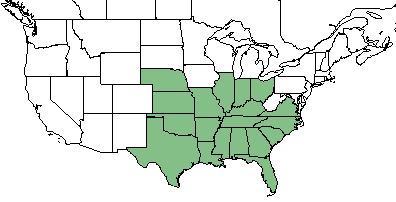Difference between revisions of "Nothoscordum bivalve"
| Line 32: | Line 32: | ||
''N. bivalve'' occurs around granite flatrocks, in various glades and barrens, open woodlands, along roadsides, fields,<ref name="Weakley 2015"/><ref name="Baskin & Baskin 1979"/> disturbed soils, low sandy woods, meadows, prairies, parking strips of towns, and rocky glades of limestone, chert, granite or sandstone. In Tennessee cedar (limestone) glades, ''N. bivalve'' is most abundant where soil is 10-15 cm deep. | ''N. bivalve'' occurs around granite flatrocks, in various glades and barrens, open woodlands, along roadsides, fields,<ref name="Weakley 2015"/><ref name="Baskin & Baskin 1979"/> disturbed soils, low sandy woods, meadows, prairies, parking strips of towns, and rocky glades of limestone, chert, granite or sandstone. In Tennessee cedar (limestone) glades, ''N. bivalve'' is most abundant where soil is 10-15 cm deep. | ||
It can be found in glades that are flooded during winter and early spring and in those that are unflooded. During summer months in this habitat, soils moisture is frequently below the wilting coefficient.<ref name="Baskin & Baskin 1979"/> | It can be found in glades that are flooded during winter and early spring and in those that are unflooded. During summer months in this habitat, soils moisture is frequently below the wilting coefficient.<ref name="Baskin & Baskin 1979"/> | ||
| + | |||
| + | Associated species in Tennessee glades include ''[[Erigeron strigosus]]'', ''Hypericum sphaerocarpum'', ''Isanthus brachiatus'', ''Isoetes butleri'', ''Ophioglossum engelmanni'', ''Petalostemon gattingeri'', ''Psoralea subacaulis'', ''Ruellia humilis'', ''Satureja glabella'', ''Scutellaria parvula'', ''Senecio smallii'', and ''Sporobolus vaginiflorus''.<ref name="Baskin & Baskin 1979"/> | ||
===Phenology=== <!--Timing off flowering, fruiting, seed dispersal, and environmental triggers. Cite PanFlora website if appropriate: http://www.gilnelson.com/PanFlora/ --> | ===Phenology=== <!--Timing off flowering, fruiting, seed dispersal, and environmental triggers. Cite PanFlora website if appropriate: http://www.gilnelson.com/PanFlora/ --> | ||
Revision as of 15:37, 8 February 2018
| Nothoscordum bivalve | |
|---|---|

| |
| Photo from the Illinois Wildflowers Database | |
| Scientific classification | |
| Kingdom: | Plantae |
| Division: | Magnoliophyta - Flowering plants |
| Class: | Magnoliopsida - Dicots |
| Order: | Liliales |
| Family: | Liliaceae |
| Genus: | Nothoscordum |
| Species: | N. bivalve |
| Binomial name | |
| Nothoscordum bivalve L. | |

| |
| Natural range of Nothoscordum bivalve from USDA NRCS Plants Database. | |
Common names: grace garlic; false garlic;[1] crowpoison[2]
Contents
Taxonomic Notes
Synonym: Allium bivalve;[1][2] Ornithogalum bivalve[2]
Description
Nothoscordum bivalve is a bulbous[3] monoecious perennial forb/herb.[2] It is an onion-like plant but typically lacks an odor.[1]
Distribution
This species is found from southeastern Virginia, westward to southern Ohio and Kansas, southward to central peninsular Florida, Texas, and South America.[1]
Ecology
Habitat
N. bivalve occurs around granite flatrocks, in various glades and barrens, open woodlands, along roadsides, fields,[1][3] disturbed soils, low sandy woods, meadows, prairies, parking strips of towns, and rocky glades of limestone, chert, granite or sandstone. In Tennessee cedar (limestone) glades, N. bivalve is most abundant where soil is 10-15 cm deep. It can be found in glades that are flooded during winter and early spring and in those that are unflooded. During summer months in this habitat, soils moisture is frequently below the wilting coefficient.[3]
Associated species in Tennessee glades include Erigeron strigosus, Hypericum sphaerocarpum, Isanthus brachiatus, Isoetes butleri, Ophioglossum engelmanni, Petalostemon gattingeri, Psoralea subacaulis, Ruellia humilis, Satureja glabella, Scutellaria parvula, Senecio smallii, and Sporobolus vaginiflorus.[3]
Phenology
In the southeastern and mid-Atlantic United States, N. bivalve flowers from mid-March through mid-May and in September through December. Fruiting occurs in May through June and from October through January.[1] For the Florida panhandle, reports of flowering primarily occur from January through May, peaking between February and April. Records of flowering also occurred in September through November, but in reduced numbers compared to the spring.[4]
Use by animals
Herbivory by grazers is low for this species,[5] but trace amounts have been found in white tailed deer rumen of southern Texas.[6] Relative abundance peaks in properly grazed prairies and overgrazed but uneroded prairies.[5]
Conservation and Management
Cultivation and restoration
Photo Gallery
References and notes
- ↑ 1.0 1.1 1.2 1.3 1.4 1.5 Weakley AS (2015) Flora of the Southern and Mid-Atlantic States. Chapel Hill, NC: University of North Carolina Herbarium.
- ↑ 2.0 2.1 2.2 2.3 USDA NRCS (2016) The PLANTS Database (http://plants.usda.gov, 08 February 2018). National Plant Data Team, Greensboro, NC 27401-4901 USA.
- ↑ 3.0 3.1 3.2 3.3 Baskin JM, Baskin CC (1979) The ecological life cycle of Nothoscordum bivalve in Tennessee cedar glades. Castanea 44(4):193-202
- ↑ Nelson G (08 February 2018) PanFlora. Retrieved from gilnelson.com/PanFlora/
- ↑ 5.0 5.1 Smith CC (1940) The effect of overgrazing and erosion upon the biota of the mixed-grass prairie of Oklahoma. Ecology 21(3):381-397.
- ↑ Everitt JH, Drawe DL (1974) Spring food habits of white-tailed deer in the south Texas plains. Journal of Range Management 27(1):15-20